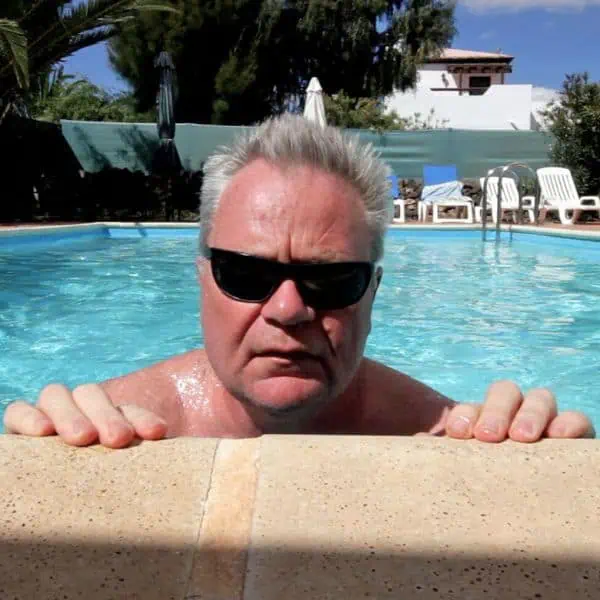It is important to know how to prime a pool vacuum hose before you start to vacuum a pool to get rid of any air that will feed into the pool filter system and perhaps create an airlock. Priming is just a more technical way of saying removing air.
There are two ways to get air out of a pool vacuum hose to prevent air locks from occurring in the pool filter system. One is to feed the hose hand-over-hand into the pool, and the other is to use the inlet jet to push the air out of the hose.
When I first got my pool, I didn’t bother removing the air, so I got air locks in my pool filter and pump as a result. Then I started using the second method, using the inlet jet described below, but soon found the “hand-over-hand feeding” method to be the quickest and easiest way to get the air out of a vacuum hose.


Why should you remove the air from a pool vacuum hose?
If you plug the vacuum hose into the vacuum head at one end and then into the hole in the skimmer without removing the air, the air in the vacuum hose will be pumped into the system. This air will end up in the pool pump and filter housing.
The air may clear itself in a few minutes without you having to do anything, but during this time, you cannot start to vacuum as you will have no suction. But it may not clear on its own as it may become an airlock, so you might have to bleed the air from the pump or filter to get rid of it.
How to prime a pool vacuum hose – my preferred method
Learning to fill pool vacuum hose with water is important to avoid getting air in the system. Also known as priming a vacuum hose, it is easy if you follow these steps:
Step 1 – lay out the hose

I first lay out the hose to remove the air from a vacuum hose to eliminate any twists or kinks.
Step 2 – attach to vacuum head

After fitting the pole to the vacuum head (most vacuum heads have a quick-release system), I then attach the vacuum hose to the fitting on the vacuum head.
Step 3 – lower the vacuum head into the pool

After securely attaching the vacuum hose, I lower the vacuum head to the bottom of the pool. I always twist it from side to side as it goes through the water to remove any air trapped under the vacuum head.
Step 4 – feed hose into the pool

Once securely on the bottom, I feed the hose into the water hand over hand. This pushes the air out of the hose as it fills with water, with the air leaving from the other, open end of the hose. Due to the water and air pressure, the water in the hose naturally tries to stay at the same level as the pool water.
Step 5 – stop when all the hose is in

I keep feeding the hose slowly, hand over hand, until all the hose is in the water apart from the top 6 inches. Do not go too quickly; otherwise, air may be trapped in any curves in the hose.
Step 6 – water will flow out

At that point, some water should flow out of the end of the hose, showing that all the air has been expelled and that the hose is full of water.
Step 7 – connect hose to skimmer port

I then feed the end of the pool vacuum hose past the skimmer weir door and push the end of the water filled hose into the rear hole of my pool skimmer. See my post Why are there two holes at the bottom of a pool skimmer?
Once securely fitted, I switch the pool pump back on and begin vacuuming.
I would typically do this with the multiport valve on the filter setting unless the pool is very dirty. In that case, I would generally use the waste setting and work quickly.
The following is a video I made for my Easy Pool Cleaning Youtube Channel showing this method of priming a vacuum hose.
Alternative method of removing air from a pool vacuum hose
The other most commonly used method of priming the pool vacuum hose is to use the return port/jet.
- The hose is attached to the vacuum head and is lowered into the water.
- The other end of the hose is then held over the water return jet so that the water flows into the hose and expels it from the other end. You should see air bubbles from the vacuum head at the bottom of the pool.
- Once no more air comes from the vacuum head, the whole hose should be full of water.
- You need to get the end you hold into the skimmer port without letting air back into the system. You can do this by keeping the end below the water level or holding the palm of your hand over the end to stop air from getting in.
Getting the open end to the skimmer is the part I have a problem with.
The skimmer is at the other end of my pool from the water return. To get the end of the hose to the skimmer using the method of keeping the end of the hose under the water, I would need to crawl along the length of my pool on my hand (only one as the other is holding the hose under the water) and knees. Perhaps a young, fit pool cleaner can do this, but that is not happening at my age.
I have tried the other method of holding the palm of my hand over the end, but inevitably, some air gets in, or I trip and let lots of air in!
If you still have an airlock, follow my guide – How to bleed air from a pool pump or filter.
Frequently Asked Questions
Why is it important to remove air from a pool vacuum hose before vacuuming?
Removing air from the vacuum hose ensures that the pool pump maintains proper suction. Air pockets can cause the pump to lose prime, reducing efficiency and potentially damaging the pump due to overheating.
How do I remove air from the pool vacuum hose?
Submerge the vacuum head and hose completely in the pool water. You can feed the hose straight down into the water, allowing it to fill with water and displace the air. Alternatively, hold the free end of the hose over a return jet until bubbles stop coming out of the vacuum head.
Can I use the pool’s return jet to help remove air from the hose?
Yes, placing the end of the hose over a return jet forces water through the hose, pushing out the air. Keep it there until no more air bubbles emerge from the vacuum head.
Why does my vacuum hose keep getting air in it during use?
Air can enter the hose if there are leaks or cracks in the hose, loose connections, or if the hose lifts out of the water while vacuuming. Inspect the hose for damage and ensure it remains submerged.
Do I need any special equipment to remove air from the vacuum hose?
No special equipment is needed. Simply using the pool water and possibly the return jet is sufficient to remove air from the hose. However, ensuring all equipment is in good working order will make the process smoother.






Leave a Reply